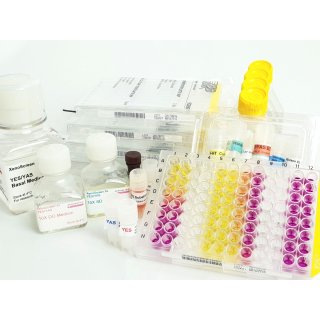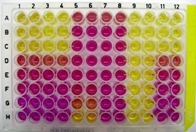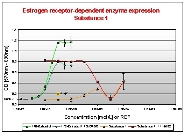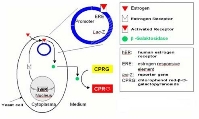XenoSc reen YES/YAS Assay kit for the detection of estrogenic and androgenic endocrine disruptors:
reen YES/YAS Assay kit for the detection of estrogenic and androgenic endocrine disruptors:
Endocrine disruptors are synthetic chemicals in the environment that mimic the actions of sex hormones and are associated with adverse reproductive and developmental effects on animal physiology.
Of major concern are such chemicals that are found in waste and surface waters, but also in certain industrial products such as plastic food containers, chemical mixtures or cosmetic products. They may interfere with the endocrine system and produce adverse developmental, reproductive, neurological and immune effects in animals and humans.
Xenometrix now offers a bioassay kit (XenoScreen YES/YAS) for the detection of substances activating or inhibiting the human estrogen and androgen receptors (agonistic and antagonistic action). The receptors are stably integrated in the yeast (Saccharomyces cerevisiae) chromosome and can activate a reporter gene system upon binding of estrogenic or androgenic compounds.



Principle of the endocrine distruptor assay
The common Baker’s or Brewer’s yeast (Saccharomyces cerevisiae) was genetically modified to identify compounds that can interact with the human estrogen and androgen receptors hERα and hAR. For this purpose the DNA sequences of hERα or hAR were stably integrated into the main chromosome of yeast cells. Additionally, the cells also contain an expression plasmid carrying the reporter gene lacZ encoding the enzyme β-galactosidase and estrogen (YES) or androgen (YAS) responsive elements (Routledge, E.J. and Sumpter, J.P. 1996. Environ. Toxicol. Chem. 13; 241-248; Sohoni, P. and Sumpter, J.P. 1998. J. Endocrinol. 158, 327-339).
Upon binding of a ligand, the hERα and hAR interact with the corresponding response elements on the expression plasmid and modulate the transcription of the lacZ reporter gene. The β-galactosidase is secreted into the medium and converts the yellow substrate chlorophenol red-β-D-galactopyranoside (CPRG) into a red product which can be quantified colorimetrically at 570 nm. The measured OD570 correlates directly with the amount of secreted β-galactosidase and thus with the activity of the test substance which binds to the corresponding receptor.
The XenoScreen YES/YAS assay system can identify both activating (agonistic) and inhibitory (antagonistic) activities of test compounds. For the determination of antagonist activities, the samples are incubated in the presence of a fixed concentration of a reference agonist (17-β estradiol for YES and 5α-dihydrotestosterone for YAS). Inhibition of the response relative to this fixed agonist concentration is a sign of antagonist activity. The assay also identifies cytotoxic effects which lead to growth arrest or lysis of the tester yeast cells. Cytotoxicity is measured as a reduction of light scatter at a wavelength of 690 nm.
Assay Description
Growing yeast cells stably transformed with either hERα (YES) or hAR (YAS) are exposed to serial dilutions of test compound, positive control chemicals (17-β estradiol for YES and 5α-dihydrotestosterone for YAS) and a combination of a fixed concentration of positive controlchemical and serial dilutions of the test compound. The cells are incubated for 48 hrs at 31°C in the presence of a substrate for β-galactosidase. The expression of β-galactosidase is directly linked to the presence of activating (agonistic) or inhibiting (antagonistic) compounds and leads to a conversion of the yellow substrate to the red cleavage product chlorophenol red. Color development and yeast growth are quantified in a spectrophotometer at 570 and 690 nm, respectively. The results are evaluated for estrogenic and androgenic agonistic and antagonistic activities as well as for yeast growth inhibition or cytotoxicity.
Please note for convenience the XenoScreen YES/YAS Assay kit does NOT include the Yeast strains- These are available to purchase separately.
Rapid, high-sensitivity, combined endocrine disruptor bioassay with YES (yeast estrogen screen) and YAS (yeast androgen screen) for the determination of hormonally active compounds (endocrine disruptors) in environmental, chemical, agrochemical, biocide, pesticide and cosmetic samples. XenoScreen YES YAS and XenoScreen XL YES YAS are in vitro estrogen and androgen receptor transcriptional activation assays. The testkits are designed to identify both activating (agonistic) and inhibiting (antagonistic) properties of test samples but allow also to test for agonistic activity only. Fresh water, waste water, aqueous extracts and leachates, or chemical, agrochemical or cosmetic compounds, and biocides, pesticides, plasticizers, detergents, fire retardants, UV filters or mixtures can be tested for endocrine disruption. The bioassay XenoScreen XL YES YAS includes additional lyticase for increased sensitivity.
Benefits:
- High sensitivity up to: 4 x 10-12 M (LoD; XenoScreen XL YES YAS)
- Standardized procedure with step-by-step instruction manual for sucessful result first-time
- Simultaneous analysis of activating (agonist) and inhibiting (antagonist) behaviour
- Results within 48 hours (XenoScreen YES YAS); 18 hours (XenoScreen XL YES YAS)
- 1–2 hours hands-on time
- Assay for concentrated or diluted samples requiring 73 μl or 16 μl (XL) as little as sample volumes
4 x 96 measuring points: Suggested configuration for XenoScreen YES YAS (2 receptors) allows analysis of 5 samples and for XenoScreen XL YES YAS (2 receptors) of 4 samples each in duplicate, 8 dilution steps, detection of agonist and antagonist activities, with positive and solvent controls. Other assay configurations are also possible.
Excel calculation sheet for evaluation of results is provided with every kit. Xenometrix also offers the evaluation of results to customers free of charge - just send your raw data.
If you cannot find the answer to your problem then please contact us or telephone +44 (0)1954 210 200